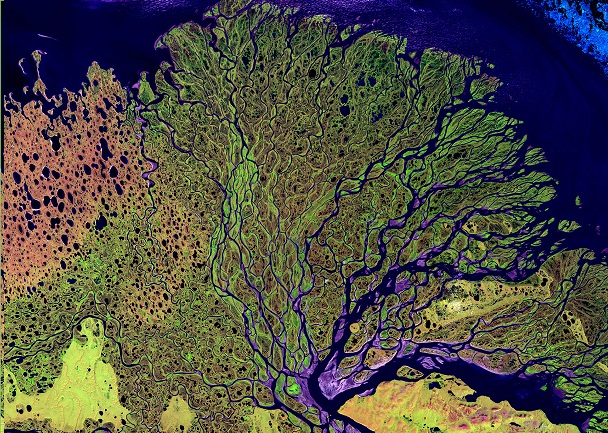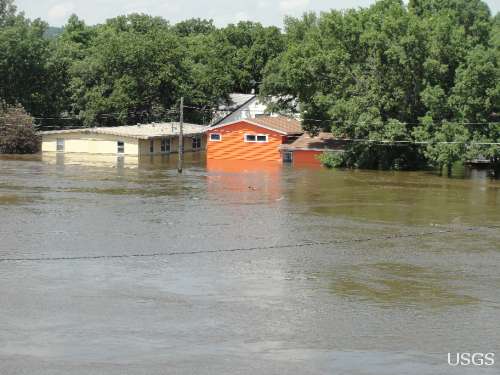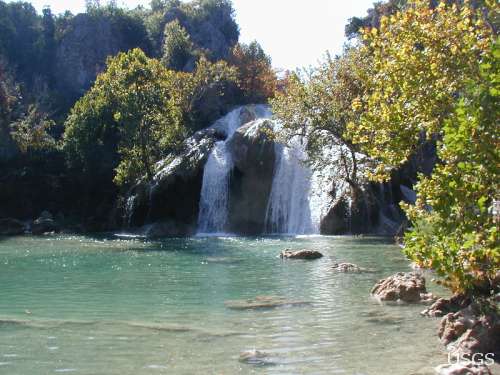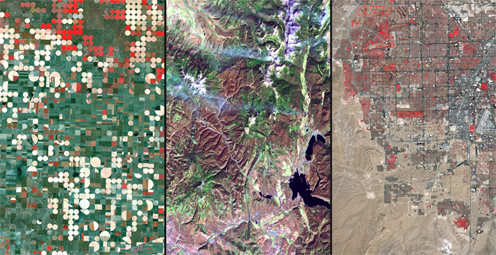
Added: Monday, July 23rd, 2012
By: Jon Campbell
The world's longest-running Earth-observing satellite program.

Added: Sunday, July 22nd, 2012
By: Barbara Wilcox
Dust storms July 21-22 blinded motorists, grounded flights and knocked out
electricity. What’s causing the dust storms?

Added: Monday, July 16th, 2012
By: Kara Capelli, Jenn LaVista, Jess Robertson
The majority of the nation is facing dry conditions; in most areas drought conditions are expected to persist or intensify. Read more

Added: Friday, June 8th, 2012
By: Jon Campbell, joncampbell@usgs.gov
A contest to celebrate 40 years of Landsat. Read more

Added: Monday, June 4th, 2012
By: David Hebert, dhebert@usgs.gov
Please comment on the USGS’ draft science strategies! Read more

Added: Monday, April 2nd, 2012
by Catherine Puckett
Timing is everything! Consider helping track changes in spring’s arrival

Added: Wednesday, March 14th, 2012
By Kara Capelli
Flood Safety Awareness Week is March. 12-16. What can you do to prepare?

Added: Tuesday, March 13th, 2012
By Kara Capelli and Kevin Dennehy
National Groundwater Awareness Week is Mar. 11-17, 2012. See how USGS science is connecting groundwater and surface water.

Added: Friday, March 9th, 2012
By Christina Nyquist
Since Japan’s March 11, 2011, Tohoku earthquake and subsequent tsunami, scientists at the USGS have learned much to help better prepare for a large earthquake in the United States.

Added: Wednesday, March 7th, 2012
By Catherine Puckett
Five USGS employees honored with Distinguished Service Awards for their service to the nation

Added: Tuesday, March 6th, 2012
By Christina Nyquist
The USGS and UNESCO have produced a book that gives us a new way to look at our shared global heritage.

Added: Wednesday, February 15th, 2012
Kara Capelli and Jeffrey Fischer
Groundwater in aquifers on the East Coast and in the Central U.S. has the highest risk of contamination from radium, a naturally occurring radioactive element and known carcinogen.

Added: Monday, February 13th, 2012
The proposed USGS budget reflects research priorities to respond to nationally relevant issues, including water quantity and quality, ecosystem restoration, hydraulic fracturing, natural disasters such as floods and earthquakes, and support for the National Ocean Policy, and has a large R&D component.

Added: Tuesday, December 20th, 2011
By Layne Adams with Catherine Puckett
Caribou expert Layne Adams discusses the lives of reindeer — apart from their famous role on Christmas Eve. How they survive the cold.

Added: Wednesday, November 30th, 2011
By <a href="mailto:jrobertson@usgs.gov ">Jessica Robertson, U.S. Geological Survey</a>
Climate science is helping to predict food shortages, identify impacts on human health, and prepare for future conditions.

Added: Wednesday, November 16th, 2011
By Jon Campbell
As demand grows, Landsat data can help us track trends in key resources. Remote-sensing satellites help scientists to observe our world, monitor changes, and detect critical trends in forestry, water, crops, and urban landscapes. Learn more.

Added: Friday, November 4th, 2011
A new study provides crucial information for difficult decisions regarding conservation, economic interests, and food and water security. Projected changes for 2010-2099

Added: Monday, October 17th, 2011
By Clarice Nassif Ransom
It's only the beginning of their careers, but these 3 young scientists have forged ahead with innovative research at the frontiers of science. How they've transformed their fields

Added: Tuesday, October 11th, 2011
By Cheryl O'Brien and Tania Larson
Oct. 9-15, 2011, is Earth Science Week, themed "Our-Ever Changing Earth," and Oct. 12, 2011, is International Day for Natural Disaster Reduction. Answers to questions posed by a changing world

Added: Friday, October 7th, 2011
By Patuxent Wildlife Research Center
By 1936, devastating losses of wildlife populations were threatening the Nation’s natural resource heritage. America's first wildlife research center

Added: Thursday, October 6th, 2011
By Seth M. Munson, Jayne Belnap, and Richard L. Reynolds
A dust storm on Tuesday, October 4, blinded motorists and caused a large string of motor vehicle crashes, multiple injuries, and at least one death. What’s causing the dust storms?
Added: Tuesday, August 16th, 2011
USGS scientists study walruses off the northwestern Alaska coast in August as part of their ongoing study of how the Pacific walrus are responding to reduced sea ice conditions in late summer and fall.
Added: Monday, August 15th, 2011
USGS scientists are collecting water samples and other data to determine trends in ocean acidification from the least explored ocean in the world.
Added: Monday, August 1st, 2011
In support of the Famine Early Warning Systems Network, USGS scientists use satellite remote sensing to assess agricultural conditions that foretell famine.
Added: Thursday, July 14th, 2011
New USGS research shows that rice could become adapted to climate change and some catastrophic events by colonizing its seeds or plants with the spores of tiny naturally occurring fungi. The DNA of the rice plant itself is not changed; instead, researchers are re-creating what normally happens in nature.
Added: Saturday, July 9th, 2011
Now that field work has wrapped up at the Ice Age "Snowmastodon" fossil site near Snowmass Village, Colo., USGS and other scientists will begin work on unraveling the climate and environmental history of the area.
Added: Thursday, July 7th, 2011
USGS scientists are studying the Earth’s conditions 3 million years ago to gain insight into the impacts of future climate. Join us Aug. 3 in Reston, Va., to learn how this information is used to better understand the magnitude of changes forecast for the end of this century.
Added: Thursday, June 30th, 2011
USGS crews continue to measure streamflow and collect water quality and sediment samples in the Ohio and Mississippi River basins using state-of-art instruments.
Added: Monday, April 18th, 2011
Over the past four decades, about 14% of the ice and permanent snow of Washington's Mount Rainier has melted due to combined recent warming and reduced precipitation.
Added: Monday, March 28th, 2011
USGS science supports management, conservation, and restoration of imperiled, at-risk, and endangered species.
Added: Sunday, March 27th, 2011
In a unique application of data, this year's report provides the nation's first assessment of birds on public lands and waters.
Added: Sunday, March 27th, 2011
The USGS, NASA, and other organizations and Federal agencies are studying how climate change affects wildlife and ecosystems.

Added: Friday, March 11th, 2011
Using coral growth records and measurements of changing ocean chemistry from increased atmospheric CO2, USGS scientists are providing a foundation for predicting future impacts of ocean acidification and sea-level rise to coral reefs.
Added: Friday, February 25th, 2011
Increased dust storm activity may result from enhanced aridity in the Southwest, according to a USGS study.
Added: Wednesday, February 9th, 2011
Provide your input on the draft USGS Global Change Science Strategy by April 8, 2011.
Added: Wednesday, December 15th, 2010
Sea-ice habitats essential to polar bears would likely respond positively should more curbs be placed on global greenhouse gas emissions, according to a new modeling study published today in the journal, Nature.
Added: Monday, December 13th, 2010
Landscape photos taken in the same place but many years apart reveal dramatic changes due to human and natural factors. The USGS Desert Laboratory Repeat Photography Collection, the largest archive of its kind
in the world, is 50 years old.
Added: Monday, December 13th, 2010
Decreasing pH and warming temperatures are changing ocean conditions and affecting coral and algal growth in South Florida. USGS scientists are conducting field measurements to learn more.
Added: Wednesday, December 1st, 2010
Many coastal wetlands worldwide including several on the U.S. Atlantic coast may be more sensitive than previously thought to climate change and sea-level rise in the this century.
Added: Monday, November 22nd, 2010
USGS findings support recent predictions that climate change will stress ecosystems at lower elevations more than higher elevations. This information may guide future conservation efforts in helping decision makers develop regional landscape predictions about biological responses to climate changes.
Added: Thursday, November 18th, 2010
The Earth as Art 3 collection, the latest set of Landsat satellite images selected for their artistic quality, reveals an intricate beauty in Earth’s natural patterns.
Added: Tuesday, November 9th, 2010
USGS scientists are investigating sea turtles and their habitats in Dry Tortugas National Park to provide insight that will be used as decision-support tools for managing coral ecosystems.
Added: Tuesday, November 9th, 2010
Looking for information on natural resources, natural hazards, geospatial data, and more? The USGS Education site provides great resources, including lessons, data, maps, and more, to support teaching, learning, K-12 education, and university-level inquiry and research.
Added: Thursday, September 23rd, 2010
The timing of animal migration and reproduction, and observing when plants send out new leaves and bear fruit, is increasingly important in understanding how climate change affects biological and hydrologic systems. Photo credit Copyright C Brandon Cole.
Added: Tuesday, June 22nd, 2010
The United States Group on Earth Observations (USGEO) is working to connect Earth observations with public health, agriculture, climate, and data management and dissemination.
Added: Tuesday, June 22nd, 2010
USGS studies the relationships among earth surface processes, ecological systems, understanding current changes in the context of prehistoric and recent earth processes, distinguishing between natural and human-influenced changes, and recognizing ecological and physical responses to changes in climate.
Added: Tuesday, June 22nd, 2010
The USGS Science Strategy is a comprehensive report to critically examine the USGS's major science goals and priorities for the coming decade. The USGS is moving forward with these strategic science directions in response to the challenges that our Nation's future faces and for the stewards of our Federal lands.
 Loading Page...
Loading Page...